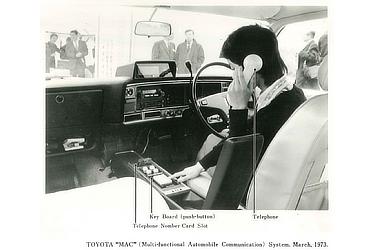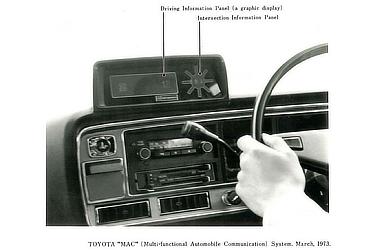Mar. 30, 1973
TOYOTA COMPUTERIZES DRIVING WITH "MAC"
MULTI-FUNCTIONAL COMMUNICATIONS SYSTEM
Five Years of Research Results in Revolutionary Car-Control Method
TOKYO―The details of an amazing automobile communications system were revealed recently at a series of technical demonstrations sponsored by Toyota Motor Co., Toyota Motor Sales Co., and the Nippon Denso Co., Ltd.
The futuristic "MAC" System is designed to simplify driving, promote traffic safety, solve traffic congestion and control problems, add to motoring convenience, and give drivers a comprehensive communications capability.
It was created after 5 years of intensive research, and was targeted for completion in time to solve the worsening driving and traffic problems of the mid-1970's.
Rapidly increasing highway congestion and rising automobile fatalities alerted the Japanese Government several years ago to the need for revolutionary approaches to the problem of traffic control. The authorities proceeded to initiate numerous measures designed to delay or avert the projected car crisis of the '70's.
Many of these steps involved the use of computers in such fields as data compilation, statistical analysis, problem simulation, direct application in variable time controls for traffic light networks, etc. But, full use of computers and advanced technology was hindered because of the absence of some form of direct communication link with each vehicle.
To solve the evolving communications gap, Japan and other advanced nations assigned scientists the task of devising methods that would permit greater application of technology to the traffic problem.
Paralleling this government effort, major automobile manufacturers started extensive research programs to help assure that evolving traffic control systems would also meet many additional requirements of motorists.
Toyota scientists reasoned that a potentiation of a computerized traffic system would not only allow for central control, but, through added informational support for the driver, could increase traffic safety, give timely warnings of emergencies and add to convenience through a comprehensive communications capability.
The result, after 5-years of research, is Toyota's "MAC"―Multifunctional Automobile Communication―System. The scientists chiefly responsible are: Professor Yujiro Hayashi of the Tokyo Institute of Technology, and Professor Hajime Akashi of Kyoto University (together with other faculty members of these institutions and key Toyota engineers and technical personnel).
The comprehensive "MAC" System is composed of 4 basic sub-systems: a car telephone unit, a computerized intersection information unit, a running information receiver unit, and an emergency information receiver unit. Individual sub-systems complement each other to generate synergy and allow "MAC" to equal more than just the sum of its parts. The system is designed to incorporate even greater capability when expansion is deemed appropriate.
The car telephone unit is equipped with either a hand held receiver or a built-in microphone and loudspeaker. Calls can be made to offices, homes, other vehicles, or elsewhere using a push-button "dialing" system. Incoming calls can originate anywhere. The telephone capability is not only a convenience, but is also linked in several ways to traffic control and safety.
A unique feature of the car telephone unit is that it has no fixed number. Numbers are assigned to individual drivers in the form of a special plastic card, which can be inserted into any vehicular telephone in the network.
Outgoing or incoming calls are routed and billed on the basis of the temporary number inserted into the unit. Another numbered card is useful for fleet operators. It can be inserted into a second slot to allow instant connection between the route vehicle and frequently called numbers, such as a company's headquarters, home, etc. This unique telephone unit will also be available independently from the "MAC" System.
The computerized intersection information unit allows drivers to ascertain the exact traffic condition existing at any one of several hundred key intersections. This advance knowledge of traffic conditions enables the driver to modify his route to avoid traffic jams. Each intersection is given a code number; the driver has merely to press the appropriate buttons and the pattern or density of traffic in a specific area will be graphically displayed on a panel.
The running information receiver unit makes it possible to display up to 34 different messages on a panel in front of the driver. Signals from loop antennas imbedded in the road are picked up by the unit and trigger messages related to speed limits, crossings, road conditions, stop signs, left or right turns permitted, school zones, etc. A metronomic warning bell alerts drivers to varying degrees of danger by the speed at which it sounds.
An emergency information receiver unit enables drivers to receive urgent communications directly through their own car radios. A small device automatically tunes the radio to a specific wave length and adjusts the volume control when an incoming message is received from a central source or a road-side antenna. This verbal emergency warning system may have numerous additional applications.
The Toyota MAC System is compact and inconspicuous, with its key components placed to insure driver convenience. The telephone push-button panel is located between the 2 front seats; the graphic display panel is located on or slightly above the dashboard instrument panel. A very small antenna extends upward at an angle above the roof, while a small pick-up coil for the running information receiver unit is located at the center of the rear bumper.
A preliminary general outline of "MAC" was first revealed last year at the 18th Tokyo Motor Show. The system, in complete operation, was shown to newsmen, government officials and industry leaders recently at the Mechanical Engineering Laboratory's Murayama Test Course on the outskirts of Tokyo. The demonstrations and tests showed that the system more than lived up to its original promise.
The tests have not only demonstrated the functional reliability of the prototype equipment, but have underlined the advantages of expanding a basic computerized traffic control method into a Multi-functional Automobile Communications System.
The rationale behind the development of the Toyota MAC System can be summarized as follows.
First, there was an urgent need for a comprehensive vehicle communications system. It is axiomatic that much of the world's progress has depended upon private enterprise's ability to "find a need and fill it;" Toyota has accomplished just that.
Second, the car has been largely ignored in the information and communications explosion that has affected our lives. Communications systems are far advanced in other forms of transport, where they improve the flow of aircraft, ship and train traffic and increase the safety of travelers.
An increasing partnership of communications and car transport is essential for 3 reasons: to assure that all road-related and vehicle-related information required for safe driving reaches the vehicle; to take full advantage of computerization; and to allow electronics to take over more of the driving function.
Third, any rational traffic control system should preserve the door-to-door convenience of vehicles and encourage the more efficient integration of vehicles into the environment. It should improve on the present system―without calling for its destruction―and be conceptually suitable for serving as the basis of predictable advances in technology.
Mr. Iwao Imazu, Toyota Motor Sales Managing Director for Business Planning and Research, recently outlined Toyota's research objectives to government officials, scientists, and the mass-media. In his remarks he stressed the necessity of relating traffic control and information control in the same organic system.
He further indicated that Toyota's MAC System concept was created to make optimal use of available communications airwaves, while providing sufficient flexibility for timely reaction to constantly changing traffic patterns.
Imazu affirmed that "Toyota has the right approach to this essential program of improvement." "Numerous traffic control concepts are now being discussed; but most of them, unfortunately, plan to replace the present system with a new system. Toyota believes that a door-to-door car function is very important."
"Toyota is planning to improve the present system, rather than to propose its total replacement, " Imazu said. The criterion for a successful program is to figuratively "equip cars with eyes, ears and mouths."
On the basis of existing evidence, a great many people think that the Toyota MAC System is the most rational and logical approach to traffic control, safety and efficiency problems of this and future decades.






